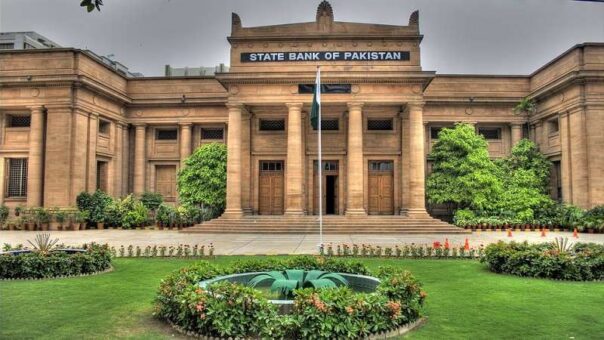Karachi, June 10, 2024 – In a move aimed at providing much-needed relief to the economy, the State Bank of Pakistan (SBP) has announced a reduction in the benchmark policy rate by 150 basis points, bringing it down to 20.5 percent.
This decision comes after maintaining a steady rate of 22 percent for nearly a year, since June 26, 2023. The new rate will be effective from June 11, 2024.
The SBP said the Monetary Policy Committee (MPC) of the SBP, in its meeting today, highlighted several factors that influenced this decision. The committee noted a significant decline in inflation since February, which was in line with expectations but better than anticipated in May. This improvement is attributed to a tight monetary policy stance supported by fiscal consolidation, which has helped moderate core inflation and ease inflation expectations among consumers and businesses.
However, the SBP said, the MPC also acknowledged potential risks to the near-term inflation outlook, including upcoming budgetary measures and uncertainties regarding future energy price adjustments. Despite these risks, the cumulative impact of earlier monetary tightening is expected to keep inflationary pressures in check.
Key Developments and Economic Indicators
GDP Growth: According to the SBP, the MPC observed that real GDP growth remained moderate at 2.4 percent in FY24, based on provisional data. This growth was primarily driven by a recovery in the agriculture sector, with modest improvements in the industry and services sectors. The government expects economic growth to remain moderate in FY25, considering the ongoing stabilization policies and expected moderation in agricultural output.
External Sector: The SBP said the current account posted a surplus for the third consecutive month in April, driven by robust growth in remittances and exports, which more than offset the increase in imports. During July-April FY24, the current account deficit narrowed significantly to $202 million. Exports grew by 10.6 percent, mainly due to increased exports of rice and high-value-added (HVA) textiles, while imports decreased by 5.3 percent due to lower international commodity prices and better domestic agricultural output. Workers’ remittances also reached an all-time high of $3.2 billion in May 2024. Improved foreign direct investment (FDI) and the disbursement of an SBA tranche in April have supported large debt repayments and bolstered the SBP’s foreign exchange reserves, which stand at around $9 billion.
Fiscal Sector: The SBP said fiscal indicators showed improvement during July-March FY24, with the primary surplus increasing to 1.5 percent of GDP. The overall deficit remained at last year’s level, reflecting higher tax and petroleum development levy (PDL) rates, increased SBP profits, and lower energy sector subsidies. The MPC emphasized the importance of broadening the tax base and reforming loss-making public sector enterprises to achieve fiscal sustainability and keep inflation on a downward trajectory.
Monetary and Credit Trends: Broad money (M2) growth decelerated to 15.2 percent year-on-year by May 24, 2024, from 17.1 percent at the end of March 2024. This deceleration was primarily due to slower growth in net domestic assets of the banking system, while net foreign assets contributed positively to M2 growth. Deposits remained the mainstay of M2 growth, while the growth of currency in circulation slowed. As a result, reserve money growth declined sharply from 10.0 percent to 4.3 percent during this period. These developments are consistent with the tight monetary policy stance and have favorable implications for the inflation outlook.
Inflation Outlook
The SBP said headline inflation decelerated to 11.8 percent in May 2024 from 17.3 percent in April. This sharp reduction was driven by a significant decline in prices of wheat, wheat flour, and other major food items, along with a downward adjustment in administered energy prices. Core inflation also decreased to 14.2 percent from 15.6 percent. The MPC noted potential risks to the near-term inflation outlook from FY25 budgetary measures and future adjustments in electricity and gas tariffs. Inflation is expected to rise significantly in July 2024 before gradually trending down during FY25.
The MPC emphasized that the current monetary policy stance remains appropriate to ensure that inflation stays on a downward trajectory. The committee highlighted the importance of timely mobilization of financial inflows to meet external financing requirements and further strengthen foreign exchange buffers to respond effectively to any external shocks and support sustainable economic growth.
Future Monetary Policy Directions
The MPC underscored that future monetary policy decisions will be data-driven and responsive to evolving developments related to the inflation outlook. Despite the recent rate cut, the real interest rate remains significantly positive, which is crucial for guiding inflation towards the medium-term target of 5-7 percent.
Conclusion
The SBP’s decision to cut the policy rate by 150 basis points to 20.5 percent reflects a cautious yet optimistic approach towards managing the country’s economic challenges. By addressing inflationary pressures and supporting economic growth, the central bank aims to create a stable and conducive environment for sustainable development. The MPC’s commitment to a data-driven approach ensures that future policy adjustments will be made with careful consideration of evolving economic conditions, ensuring that Pakistan remains on the path to fiscal and economic stability.
